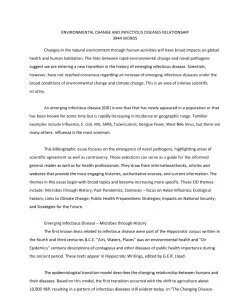ENVIRONMENTAL CHANGE AND INFECTIOUS DISEASES RELATIONSHIP 3944 WORDS
ENVIRONMENTAL CHANGE AND INFECTIOUS DISEASES RELATIONSHIP 3944 WORDS
ENVIRONMENTAL CHANGE AND INFECTIOUS DISEASES RELATIONSHIP
3944 WORDS
Changes in the natural environment through human activities will have broad impacts on global health and human habitation. The links between rapid environmental change and novel pathogens suggest we are entering a new transition in the history of emerging infectious disease. Scientists, however, have not reached consensus regarding an increase of emerging infectious diseases under the broad conditions of environmental change and climate change. This is an area of intense scientific scrutiny.
An emerging infectious disease [EID] is one that that has newly appeared in a population or that has been known for some time but is rapidly increasing in incidence or geographic range. Familiar examples include Influenza, E. coli, HIV, SARS, Tuberculosis, Dengue Fever, West Nile Virus, but there are many others. Influenza is the most common.
